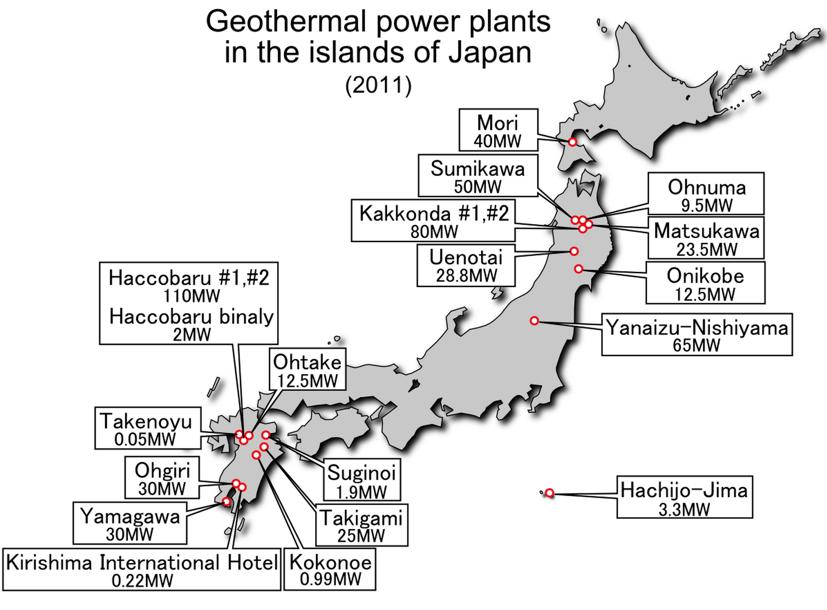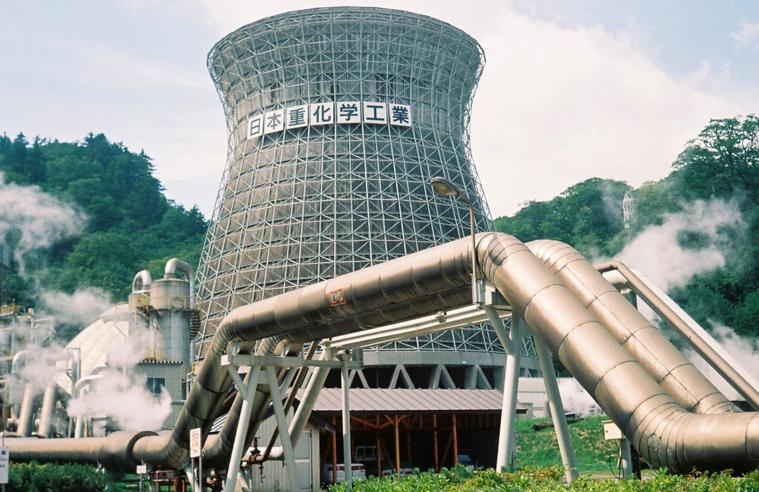Television viewers across Japan watched as workers in the control room of Kyushu Electric's Sendai nuclear reactor No. 1 pulled out 32 control rods so that it could be the first to go back online after the 2011 Fukushima nuclear accident.
This was a milestone because Japan has always been an "energy island," forced to import all of its oil, gas and coal (the conventional hydrocarbons), to accompany its nuclear fuel. Ironically, that's only partially true. For decades, the monopoly utilities ignored the country's only abundant energy — geothermal, a baseload power source as reliable as nuclear — leaving a potential 23GW of power, steamily volcano-adjacent and unused.
In addition to avoiding high prices for fuel oil and LNG, because Kyushu Electric's reactivated Sendai nuclear reactor is also volcano-adjacent — like many others — the government has shifted resources to renewable energy, including important new regulations that encourage geothermal exploration.
The government wants to turn the possibility of an eruption of Mount Sakurajima, 30 miles from Sendai — which happens constantly — along with the country's other 110 active volcanoes, into an advantage by using nearby geothermal energy. But even though Japan's geothermal potential is estimated to be the third largest in the world after the United States and Indonesia, only two percent has been developed.

To jump start the industry, the government set up a special 15-year feed-in tariff (FIT) just for geothermal projects, which is even more liberal than the solar and wind FIT. The Ministry of Economy, Trade and Industry (METI) now expects 380 to 850 MW of new installed geothermal capacity by 2030.
Breaking up is hard to do
Once you accept that monopolies look for big, centralized solutions, which made going nuclear in Japan a no-brainer during the early 70s, the other reason for the lack of geothermal power in Japan has been strong resistance from local communities protecting their hot spring tourist magnets. Many other off-limit sites, about 80 percent, are protected by the government in national forests.
Now three years after Fukushima, the national mood has shifted.
In 2012, along with the new geothermal FIT, the Ministry of the Environment relaxed the rules in the parks, promoting active development. "Keeping a balance between geothermal power and national parks has been a very big issue," said environment minister Goshi Hosono during a press conference when the new rules were released. "We plan to develop geothermal power in earnest as the importance of renewable energy is increasing."
At the same time, the government increased funding for geothermal exploratory drilling from $15 million to $90 million. Exploratory drilling, which is considered the most costly and risky aspect of a project, accounts for about 50 percent of geothermal costs. These measures quickly created new geothermal development and the beginning of the Japan Geothermal Association (JGA), which already supports more than 50 companies.
Catching fire
Last year, long before the nuclear restart, Japan commissioned its first new geothermal power plant in 15 years in the Kumamoto prefecture, on the island of Kyushu. It's near the Sendai nuclear plant in a region famed for its natural hot springs and volcanic activity.

The project was developed by the Chuo Electric Power Co, which plans to open five more plants.
Chuo, a Tokyo-based company that makes bulk purchases of electricity to supply power to condominium households at low prices, built the geothermal plant with a firm called Waita-kai, operated by residents in a hot spring resort in Oguni, Kumamoto Prefecture.
Although the power plant has a maximum output of 2,000 kilowatts and serves only 1,500 households, it's still the first geothermal plant greater than 1,000 KW since 1999, when Tokyo Electric Power Co.’s Hachijojima Geothermal Power Station was put into operation on Hachijo Island, south of Tokyo.

The government also provided an incentive to go small. Large-scale geothermal plants require environmental assessments that can take up to four years, while smaller geothermal plants can legally side-step the whole process.
The opening of the small plant marked the start of a flurry of geothermal projects launched across the country, with a string of other companies following suit from northernmost Hokkaido to southern Kyushu.
The government has been monitoring the boom and reports that more than 60 spots around the country are being tapped by as possible sites for plants.
“It is much better for nations to have their own energy resources in terms of national security, and geothermal is a domestic and abundant energy source in Japan,” Masaho Adachi, geothermal energy expert and former chairman of Japan Geothermal Developers Council told the Telegraph.
The big boys
Now the big money is starting to flood the zone.
SoftBank Group, the Japanese IT giant, which already intends to build 27 huge solar power plants across Japan by fiscal 2017, has plans to move into geothermal energy, a more reliable energy resource, in order to ensure a more stable supply as an electricity retailer.
As a first step, it has begun a field study to build a small 300kW binary-cycle geothermal power plant in the city of Itoigawa in southern Niigata Prefecture. The company expects to begin construction in one to two years and launch operations by 2020, to take advantage of the feed-in tariff.
In the future, SoftBank may build large geothermal power plants. But for now it will focus on plants that generate less than 7,500kW because the smaller plants can start up sooner, and SoftBank can quickly gain the experience needed to expand the business later.
Concerns over nuclear energy's safety
Back at the Sendai reactor problems remain. Nearby there are five caldera (a collasped volcanic crater) which have caused massive eruptions in the past. Kyushu Electric argued during its safety assessment by the Nuclear regulatory Agency (NRA) that the possibility of a massive eruption while the reactor is in operation was sufficiently low, and indicated that it would stop the reactor and transport nuclear fuel out if any signs of an eruption were detected. Where the nuclear fuel would be transported, however, has not been decided, according to Mainichi.
Although the NRA agreed with Kyushu Electric, many volcanologists have pointed out the difficulty of detecting signs of volcanic activity, since almost no observational records of massive eruptions exist. In response, the NRA established a panel of experts that would advise the NRA, but the panel is not expected to meet — at the earliest — until this fall, after commercial operation of the Sendai No. 1 reactor has begun.
Will geothermal solve Japan's limited land problem?
Images: Geothermal graphic, Shigeru23; large eothermal plant, Si-take; small geothermal, Chuo Electric


